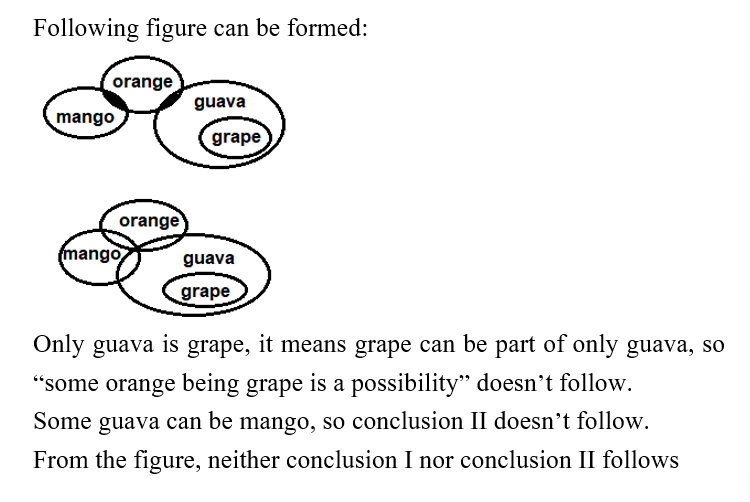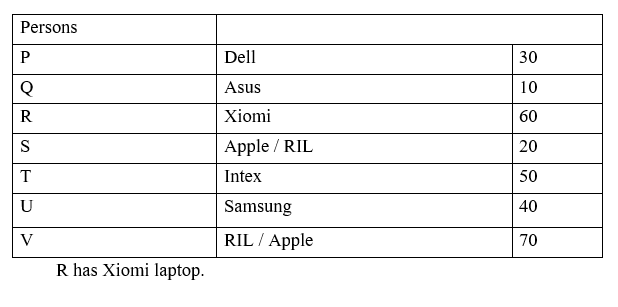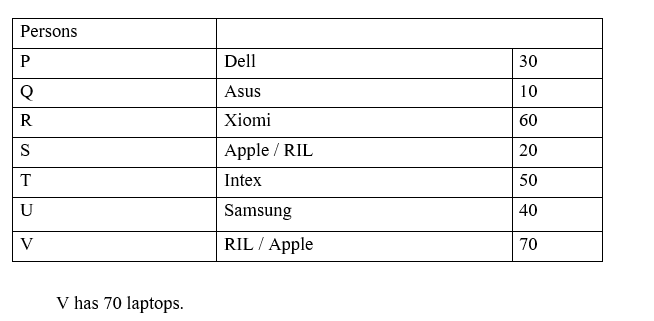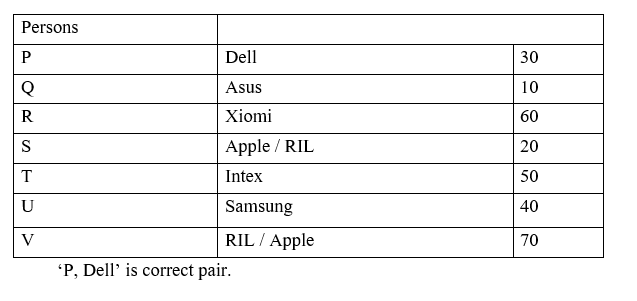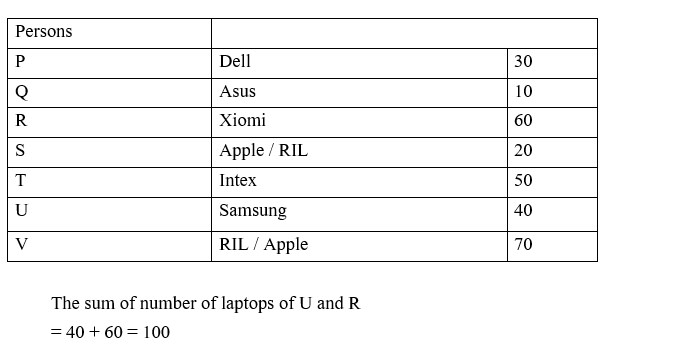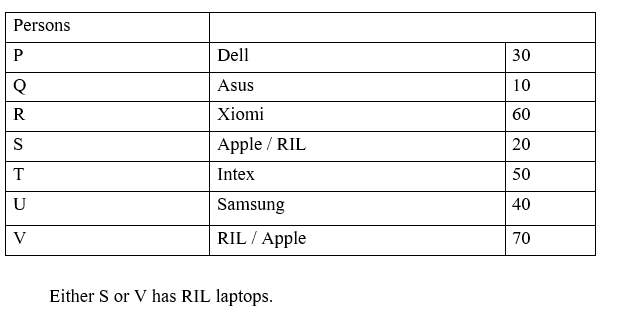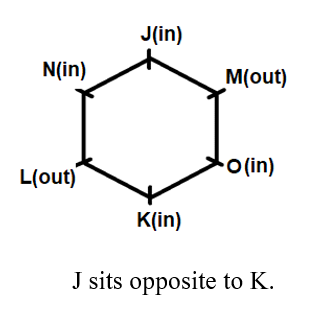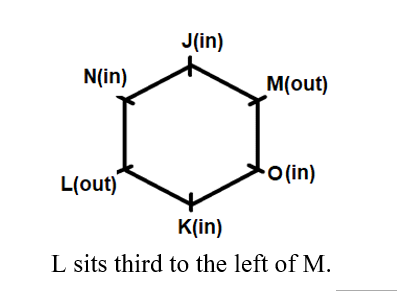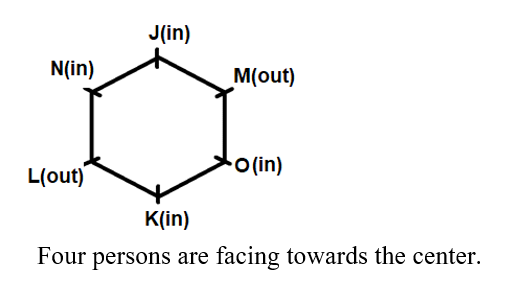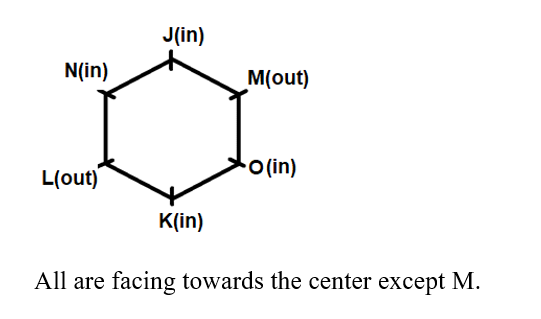Question 1:
Direction: In the question below there are three statements followed by two conclusions I and II. You have to take the three given statements to be true even if they seem to be at variance from commonly known facts and then decide which of the given conclusions logically follows from the three statements disregarding commonly known facts.
निर्देश: प्रश्न में, तीन कथन और उसके बाद दो निष्कर्ष I और II दिए गए हैं। आपको दिए गए तीन कथनों को सत्य मानना है, भले ही वे सामान्य रूप से ज्ञात तथ्यों से भिन्न दिखाई देते हों और फिर तय करें कि दिए गए निष्कर्षों में से कौन-सा निष्कर्ष सामान्य रूप से ज्ञात तथ्यों की अवहेलना करते हुए तीन कथनों का तार्किक रूप से अनुसरण करता है।
Statements: Only a few mango is orange
कथन: केवल कुछ आम संतरा है
Only few orange is guava
केवल कुछ संतरा अमरुद है
Only guava is grape
केवल अमरुद अंगूर है
Conclusions: I. Some orange being grape is a possibility
निष्कर्ष: I. कुछ संतरा के अंगूर होने की संभावना है
II. No guava is mango
II. कोई अमरुद आम नहीं है
(A) Only conclusion II follows
(A) केवल निष्कर्ष II अनुसरण करता है
(B) Only conclusion I follows
(B) केवल निष्कर्ष I अनुसरण करता है
(C) Neither conclusion I nor conclusion II follows
(C) न तो निष्कर्ष I और न ही निष्कर्ष II अनुसरण करता है
(D) Both conclusion I and conclusion II follow.
(D) निष्कर्ष I और निष्कर्ष II दोनों अनुसरण करते हैं।
(E) None of the above
(E) उपर्युक्त कोई नहीं
Question 2:
Directions Answer the questions based on the information given below.
निर्देश: नीचे दी गई जानकारी के आधार पर प्रश्नों के उत्तर दें।
Seven persons P, Q, R, S, T, U and V have different number of laptops among 10, 20, 30, 40, 50, 60 and 70 but not necessarily in same order. Each of them has laptop of different brands among Asus, Apple, Dell, Intex, RIL, Samsung, Xiomi.
U has Samsung laptops.S has 20 laptops. The difference in number of laptops of P and V is 40.One person has 60 Xiomi laptops. Neither Q nor T has Xiomi laptops. V has more laptops than that of R. One person has 50 intex laptops. T has more laptops than U, who does not have only 10 laptops. There are 20 more Dell laptops than Asus laptops.
सात व्यक्तियों P, Q, R, S, T, U और V के पास 10, 20, 30, 40, 50, 60 और 70 में से अलग-अलग संख्या में लैपटॉप हैं, लेकिन जरूरी नहीं कि इसी क्रम में हों। उनमें से प्रत्येक के पास एसस, एप्पल, डेल, इंटेक्स, RIL, सैमसंग, जिओमी के बीच विभिन्न ब्रांड के लैपटॉप हैं।
U के पास सैमसंग लैपटॉप हैं। S के पास 20 लैपटॉप हैं। P और V के लैपटॉप की संख्या का अंतर 40 है। एक व्यक्ति के पास 60 जिओमी लैपटॉप हैं। न तो Q और न ही T के पास जिओमी लैपटॉप हैं। V के पास R से अधिक लैपटॉप हैं। एक व्यक्ति के पास 50 इंटेक्स लैपटॉप हैं। T के पास U से अधिक लैपटॉप हैं और U के पास केवल 10 लैपटॉप नहीं हैं। एसस लैपटॉप से डेल लैपटॉप 20 अधिक हैं।
Who among the following has Xiomi laptop?
निम्नलिखित में से किसके पास जिओमी लैपटॉप है?
Question 3:
Directions Answer the questions based on the information given below.
निर्देश: नीचे दी गई जानकारी के आधार पर प्रश्नों के उत्तर दें।
Seven persons P, Q, R, S, T, U and V have different number of laptops among 10, 20, 30, 40, 50, 60 and 70 but not necessarily in same order. Each of them has laptop of different brands among Asus, Apple, Dell, Intex, RIL, Samsung, Xiomi.
U has Samsung laptops.S has 20 laptops. The difference in number of laptops of P and V is 40.One person has 60 Xiomi laptops. Neither Q nor T has Xiomi laptops. V has more laptops than that of R. One person has 50 intex laptops. T has more laptops than U, who does not have only 10 laptops. There are 20 more Dell laptops than Asus laptops.
सात व्यक्तियों P, Q, R, S, T, U और V के पास 10, 20, 30, 40, 50, 60 और 70 में से अलग-अलग संख्या में लैपटॉप हैं, लेकिन जरूरी नहीं कि इसी क्रम में हों। उनमें से प्रत्येक के पास एसस, एप्पल, डेल, इंटेक्स, RIL, सैमसंग, जिओमी के बीच विभिन्न ब्रांड के लैपटॉप हैं।
U के पास सैमसंग लैपटॉप हैं। S के पास 20 लैपटॉप हैं। P और V के लैपटॉप की संख्या का अंतर 40 है। एक व्यक्ति के पास 60 जिओमी लैपटॉप हैं। न तो Q और न ही T के पास जिओमी लैपटॉप हैं। V के पास R से अधिक लैपटॉप हैं। एक व्यक्ति के पास 50 इंटेक्स लैपटॉप हैं। T के पास U से अधिक लैपटॉप हैं और U के पास केवल 10 लैपटॉप नहीं हैं। एसस लैपटॉप से डेल लैपटॉप 20 अधिक हैं।
V has _____ laptops.
V के पास _____ लैपटॉप हैं।
Question 4:
Directions Answer the questions based on the information given below.
निर्देश: नीचे दी गई जानकारी के आधार पर प्रश्नों के उत्तर दें।
Seven persons P, Q, R, S, T, U and V have different number of laptops among 10, 20, 30, 40, 50, 60 and 70 but not necessarily in same order. Each of them has laptop of different brands among Asus, Apple, Dell, Intex, RIL, Samsung, Xiomi.
U has Samsung laptops.S has 20 laptops. The difference in number of laptops of P and V is 40.One person has 60 Xiomi laptops. Neither Q nor T has Xiomi laptops. V has more laptops than that of R. One person has 50 intex laptops. T has more laptops than U, who does not have only 10 laptops. There are 20 more Dell laptops than Asus laptops.
सात व्यक्तियों P, Q, R, S, T, U और V के पास 10, 20, 30, 40, 50, 60 और 70 में से अलग-अलग संख्या में लैपटॉप हैं, लेकिन जरूरी नहीं कि इसी क्रम में हों। उनमें से प्रत्येक के पास एसस, एप्पल, डेल, इंटेक्स, RIL, सैमसंग, जिओमी के बीच विभिन्न ब्रांड के लैपटॉप हैं।
U के पास सैमसंग लैपटॉप हैं। S के पास 20 लैपटॉप हैं। P और V के लैपटॉप की संख्या का अंतर 40 है। एक व्यक्ति के पास 60 जिओमी लैपटॉप हैं। न तो Q और न ही T के पास जिओमी लैपटॉप हैं। V के पास R से अधिक लैपटॉप हैं। एक व्यक्ति के पास 50 इंटेक्स लैपटॉप हैं। T के पास U से अधिक लैपटॉप हैं और U के पास केवल 10 लैपटॉप नहीं हैं। एसस लैपटॉप से डेल लैपटॉप 20 अधिक हैं।
Which of the following pair is correct?
निम्नलिखित में से कौन-सा जोड़ा सही है?
Question 5:
Directions Answer the questions based on the information given below.
निर्देश: नीचे दी गई जानकारी के आधार पर प्रश्नों के उत्तर दें।
Seven persons P, Q, R, S, T, U and V have different number of laptops among 10, 20, 30, 40, 50, 60 and 70 but not necessarily in same order. Each of them has laptop of different brands among Asus, Apple, Dell, Intex, RIL, Samsung, Xiomi.
U has Samsung laptops.S has 20 laptops. The difference in number of laptops of P and V is 40.One person has 60 Xiomi laptops. Neither Q nor T has Xiomi laptops. V has more laptops than that of R. One person has 50 intex laptops. T has more laptops than U, who does not have only 10 laptops. There are 20 more Dell laptops than Asus laptops.
सात व्यक्तियों P, Q, R, S, T, U और V के पास 10, 20, 30, 40, 50, 60 और 70 में से अलग-अलग संख्या में लैपटॉप हैं, लेकिन जरूरी नहीं कि इसी क्रम में हों। उनमें से प्रत्येक के पास एसस, एप्पल, डेल, इंटेक्स, RIL, सैमसंग, जिओमी के बीच विभिन्न ब्रांड के लैपटॉप हैं।
U के पास सैमसंग लैपटॉप हैं। S के पास 20 लैपटॉप हैं। P और V के लैपटॉप की संख्या का अंतर 40 है। एक व्यक्ति के पास 60 जिओमी लैपटॉप हैं। न तो Q और न ही T के पास जिओमी लैपटॉप हैं। V के पास R से अधिक लैपटॉप हैं। एक व्यक्ति के पास 50 इंटेक्स लैपटॉप हैं। T के पास U से अधिक लैपटॉप हैं और U के पास केवल 10 लैपटॉप नहीं हैं। एसस लैपटॉप से डेल लैपटॉप 20 अधिक हैं।
What is the sum of number of laptops of U and R?
U और R के लैपटॉप की संख्या का योग क्या है?
Question 6:
Directions Answer the questions based on the information given below.
निर्देश: नीचे दी गई जानकारी के आधार पर प्रश्नों के उत्तर दें।
Seven persons P, Q, R, S, T, U and V have different number of laptops among 10, 20, 30, 40, 50, 60 and 70 but not necessarily in same order. Each of them has laptop of different brands among Asus, Apple, Dell, Intex, RIL, Samsung, Xiomi.
U has Samsung laptops.S has 20 laptops. The difference in number of laptops of P and V is 40.One person has 60 Xiomi laptops. Neither Q nor T has Xiomi laptops. V has more laptops than that of R. One person has 50 intex laptops. T has more laptops than U, who does not have only 10 laptops. There are 20 more Dell laptops than Asus laptops.
सात व्यक्तियों P, Q, R, S, T, U और V के पास 10, 20, 30, 40, 50, 60 और 70 में से अलग-अलग संख्या में लैपटॉप हैं, लेकिन जरूरी नहीं कि इसी क्रम में हों। उनमें से प्रत्येक के पास एसस, एप्पल, डेल, इंटेक्स, RIL, सैमसंग, जिओमी के बीच विभिन्न ब्रांड के लैपटॉप हैं।
U के पास सैमसंग लैपटॉप हैं। S के पास 20 लैपटॉप हैं। P और V के लैपटॉप की संख्या का अंतर 40 है। एक व्यक्ति के पास 60 जिओमी लैपटॉप हैं। न तो Q और न ही T के पास जिओमी लैपटॉप हैं। V के पास R से अधिक लैपटॉप हैं। एक व्यक्ति के पास 50 इंटेक्स लैपटॉप हैं। T के पास U से अधिक लैपटॉप हैं और U के पास केवल 10 लैपटॉप नहीं हैं। एसस लैपटॉप से डेल लैपटॉप 20 अधिक हैं।
Who among the following has RIL laptops?
निम्नलिखित में से किसके पास आर आई एल लैपटॉप हैं?
Question 7:
Directions : Answer the questions based on the information given below.
नीचे दी गई जानकारी के आधार पर प्रश्नों के उत्तर दें।
Six persons, J, K, L, M, N and O are sitting at the corners of hexagonal shaped table. Some of them facing towards the center while others are facing outside the table.
One person is sitting between N and M but both of them facing opposite directions with respect to each other (i.e. if N facing towards the center then M must be facing away from the center and vice versa). N sits second to the left of K, who faces towards the center. O sits second to the left of L, who faces outside the table. L sits 2nd to the right of J, who sits immediate left of M. L and O face the opposite directions with respect to each other. O and M are immediate right of each other.
छह व्यक्ति, J, K, L, M, N और O षट्कोणीय आकार की मेज के कोनों पर बैठे हैं। उनमें से कुछ व्यक्तियों का मुख केंद्र की ओर है जबकि अन्य के मुख मेज के केंद्र से बाहर की ओर है।
एक व्यक्ति N और M के बीच में बैठा है, लेकिन दोनों का मुख एक दूसरे के सन्दर्भ में विपरीत दिशाओं की ओर है (अर्थात यदि N का मुख केंद्र की ओर है तो M का मुख केंद्र से बाहर की ओर होना चाहिए और इसके विपरीत)। N K के बाएं से दूसरे स्थान पर बैठा है और K का मुख केंद्र की ओर है। O L के बाएं से दूसरे स्थान पर बैठा है और L का मुख मेज के केंद्र से बाहर की ओर है। L J के दाएं से दूसरे स्थान पर बैठा है और J M के तत्काल बाएं ओर बैठा है। L और O एक दूसरे के सन्दर्भ में विपरीत दिशाओं की ओर मुख किए हुए हैं। O और M एक दूसरे के तत्काल दाएं ओर बैठे हैं।
Who sits opposite to K in the table?
K के विपरीत कौन बैठा है?
Question 8:
Directions : Answer the questions based on the information given below.
नीचे दी गई जानकारी के आधार पर प्रश्नों के उत्तर दें।
Six persons, J, K, L, M, N and O are sitting at the corners of hexagonal shaped table. Some of them facing towards the center while others are facing outside the table.
One person is sitting between N and M but both of them facing opposite directions with respect to each other (i.e. if N facing towards the center then M must be facing away from the center and vice versa). N sits second to the left of K, who faces towards the center. O sits second to the left of L, who faces outside the table. L sits 2nd to the right of J, who sits immediate left of M. L and O face the opposite directions with respect to each other. O and M are immediate right of each other.
छह व्यक्ति, J, K, L, M, N और O षट्कोणीय आकार की मेज के कोनों पर बैठे हैं। उनमें से कुछ व्यक्तियों का मुख केंद्र की ओर है जबकि अन्य के मुख मेज के केंद्र से बाहर की ओर है।
एक व्यक्ति N और M के बीच में बैठा है, लेकिन दोनों का मुख एक दूसरे के सन्दर्भ में विपरीत दिशाओं की ओर है (अर्थात यदि N का मुख केंद्र की ओर है तो M का मुख केंद्र से बाहर की ओर होना चाहिए और इसके विपरीत)। N K के बाएं से दूसरे स्थान पर बैठा है और K का मुख केंद्र की ओर है। O L के बाएं से दूसरे स्थान पर बैठा है और L का मुख मेज के केंद्र से बाहर की ओर है। L J के दाएं से दूसरे स्थान पर बैठा है और J M के तत्काल बाएं ओर बैठा है। L और O एक दूसरे के सन्दर्भ में विपरीत दिशाओं की ओर मुख किए हुए हैं। O और M एक दूसरे के तत्काल दाएं ओर बैठे हैं।
Who sits third to the left of M?
M के बाएं से तीसरे स्थान पर कौन बैठा है?
Question 9:
Directions : Answer the questions based on the information given below.
नीचे दी गई जानकारी के आधार पर प्रश्नों के उत्तर दें।
Six persons, J, K, L, M, N and O are sitting at the corners of hexagonal shaped table. Some of them facing towards the center while others are facing outside the table.
One person is sitting between N and M but both of them facing opposite directions with respect to each other (i.e. if N facing towards the center then M must be facing away from the center and vice versa). N sits second to the left of K, who faces towards the center. O sits second to the left of L, who faces outside the table. L sits 2nd to the right of J, who sits immediate left of M. L and O face the opposite directions with respect to each other. O and M are immediate right of each other.
छह व्यक्ति, J, K, L, M, N और O षट्कोणीय आकार की मेज के कोनों पर बैठे हैं। उनमें से कुछ व्यक्तियों का मुख केंद्र की ओर है जबकि अन्य के मुख मेज के केंद्र से बाहर की ओर है।
एक व्यक्ति N और M के बीच में बैठा है, लेकिन दोनों का मुख एक दूसरे के सन्दर्भ में विपरीत दिशाओं की ओर है (अर्थात यदि N का मुख केंद्र की ओर है तो M का मुख केंद्र से बाहर की ओर होना चाहिए और इसके विपरीत)। N K के बाएं से दूसरे स्थान पर बैठा है और K का मुख केंद्र की ओर है। O L के बाएं से दूसरे स्थान पर बैठा है और L का मुख मेज के केंद्र से बाहर की ओर है। L J के दाएं से दूसरे स्थान पर बैठा है और J M के तत्काल बाएं ओर बैठा है। L और O एक दूसरे के सन्दर्भ में विपरीत दिशाओं की ओर मुख किए हुए हैं। O और M एक दूसरे के तत्काल दाएं ओर बैठे हैं।
How many persons are facing towards the center of the table?
कितने व्यक्तियों का मुख मेज के केंद्र की ओर है?
Question 10:
Directions : Answer the questions based on the information given below.
नीचे दी गई जानकारी के आधार पर प्रश्नों के उत्तर दें।
Six persons, J, K, L, M, N and O are sitting at the corners of hexagonal shaped table. Some of them facing towards the center while others are facing outside the table.
One person is sitting between N and M but both of them facing opposite directions with respect to each other (i.e. if N facing towards the center then M must be facing away from the center and vice versa). N sits second to the left of K, who faces towards the center. O sits second to the left of L, who faces outside the table. L sits 2nd to the right of J, who sits immediate left of M. L and O face the opposite directions with respect to each other. O and M are immediate right of each other.
छह व्यक्ति, J, K, L, M, N और O षट्कोणीय आकार की मेज के कोनों पर बैठे हैं। उनमें से कुछ व्यक्तियों का मुख केंद्र की ओर है जबकि अन्य के मुख मेज के केंद्र से बाहर की ओर है।
एक व्यक्ति N और M के बीच में बैठा है, लेकिन दोनों का मुख एक दूसरे के सन्दर्भ में विपरीत दिशाओं की ओर है (अर्थात यदि N का मुख केंद्र की ओर है तो M का मुख केंद्र से बाहर की ओर होना चाहिए और इसके विपरीत)। N K के बाएं से दूसरे स्थान पर बैठा है और K का मुख केंद्र की ओर है। O L के बाएं से दूसरे स्थान पर बैठा है और L का मुख मेज के केंद्र से बाहर की ओर है। L J के दाएं से दूसरे स्थान पर बैठा है और J M के तत्काल बाएं ओर बैठा है। L और O एक दूसरे के सन्दर्भ में विपरीत दिशाओं की ओर मुख किए हुए हैं। O और M एक दूसरे के तत्काल दाएं ओर बैठे हैं।
Four of the following five are related to each other in some way and thus formed a group. Choose the one which does not belong to that group.
निम्नलिखित पांच में से चार किसी न किसी रूप में एक दूसरे से संबंधित हैं और इस प्रकार एक समूह बनाते हैं। वह चुनें जो उस समूह से संबंधित नहीं है।

